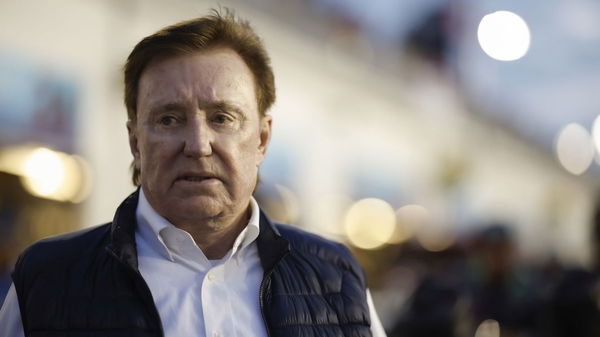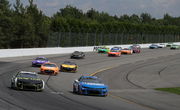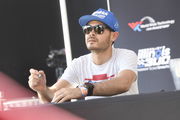

The recent disqualification of Jesse Love at Rockingham has turned the heat up to unbearable levels. Fans are grappling with a mix of heartbreak, confusion, and outright frustration as Richard Childress Racing fights a losing battle against NASCAR’s ironclad rulebook. Love, a 20-year-old driver with fire in his veins, crosses the Rockingham finish line first, tasting what should’ve been his career-defining first Xfinity Series win. The cheers were deafening, but the celebration crashed hard when NASCAR declared his No. 2 car illegal due to a modified rear suspension, stripping him of the victory and handing it to Sammy Smith.
RCR, led by the fiercely competitive Richard Childress, wasn’t about to roll over. They filed an appeal to the National Motorsports Appeals Panel, hoping to reverse the disqualification and restore Love’s win. But the panel delivered a unanimous verdict: “The panel finds that it is more likely than not that there was a violation of 14.14.2 Rear Suspension, I-5. The panel was unable to determine whether the violation was intentional or unintentional. The panel finds that the mating surfaces between the truck trailing arm and the U-bolt saddle were not in contact with each other.” The ruling hit like a sledgehammer, leaving RCR, Love, and their fans reeling.
ADVERTISEMENT
Article continues below this ad
NASCAR put on a show at Talladega to justify their claims
NASCAR’s managing director, Brad Moran, provided further clarity, quoting: “The rear suspension was modified in a way that provided an aerodynamic and mechanical advantage, which is against our rules. It was a clear violation of the NASCAR Rule Book, Section 14.3.2, which governs suspension components.” Moran emphasized the modification’s impact: “The altered suspension allowed for better weight distribution and tire contact, enhancing the car’s performance in corners, which gave an unfair edge.” This likely meant improved right rear tire grip, which is crucial for Rockingham’s tight turns. Yet, for fans without a technical background, the exact advantage remained elusive, fueling heated debates.
The aftermath was relentless. NASCAR didn’t stop at the penalty; they made a bold statement by putting the illegal rear suspension on display at Talladega Superspeedway, as detailed by NASCAR.com on April 25, 2025. The part was flagged for providing an “aerodynamic and mechanical advantage,” a clear violation of NASCAR’s technical regulations. NASCAR’s move to showcase the infraction caught everyone’s attention. This was a shift from NASCAR’s usual hush-hush approach to penalties, offering fans a rare glimpse at the evidence. “What happens when you go into the corner and all this stuff is not tight is the load on the suspension moves left,” said Eric Peterson, managing director of the Xfinity Series. He added further, “and the cornering load moves right with the body and will move the right rear of the body towards the wall and adds side force to the car, which is where the performance advantage comes from. It skews it out.”
Xfinity Series Director Eric Peterson explains the issue on the Jesse Love car from Rockingham that resulted in the disqualification. @NASCARONFOX pic.twitter.com/AQWS24WZ6o
— Bob Pockrass (@bobpockrass) April 25, 2025
He stood by the No. 2 car’s left-side truck arm, the rear-end housing, the U-Bolt saddle, and the lowering block. The rule violated at Rockingham was that all the mating surfaces between the U-Bolt saddle and the truck trailing arm were not in complete contact with each other. A significant gap was visible. The display, as NASCAR.com explained on April 23, 2025, was meant to clarify the violation: “The rear suspension component was altered in a manner that manipulated the car’s handling characteristics beyond permissible limits, specifically affecting tire grip and aerodynamic performance.” But instead of settling the debate, it sparked more questions. How much of an edge did this give? Was it worth throwing out a win? The tweak likely boosted right rear tire grip, improving cornering stability—a critical advantage on Rockingham’s demanding turns.
Richard Childress Racing’s appeal was a desperate bid to save Love’s victory, but the details of their argument were murky. They argued the penalty was disproportionate, pointing to the “spirit of competition” and possibly suggesting the modification’s impact was minimal. But the panel, consisting of industry experts, wasn’t convinced. RCR’s appeal argued the modification was within the spirit of competition, but NASCAR disagreed. The rejection was a bitter pill, leaving fans to pick apart what went wrong.
What’s your perspective on:
Did NASCAR's harsh penalty on Jesse Love kill the spirit of competition at Rockingham?
Have an interesting take?
Love himself didn’t let the setback define him. His nod to JR Motorsports’ successful 2022 appeal for Noah Gragson’s Darlington race stirred fans’ frustration over perceived inconsistencies in NASCAR’s rulings. Yet Love bounced back, clinching the Talladega pole. It was a moment of redemption, but the Rockingham wound still stung.
Now, let’s dive into the fans’ reactions, which are as raw and varied as the sport itself.
Trending
ADVERTISEMENT
Article continues below this ad
Fans are curious about RCR’s motive for the appeal
The disconnect between NASCAR’s policies and fan sentiment is glaring. One fan tweeted, “There’s a bigger gap between public opinion and NASCAR policy.” This sums up the growing divide, as fans feel NASCAR’s rigid rules sometimes squash the competitive heart of racing. Coverage of the disqualification noted fans’ outrage, with many arguing the penalty was too harsh for a technical violation. The public display of the suspension only deepened their skepticism about NASCAR’s consistency.
Another fan speculated, “There’s no way this wasn’t also the case on the 17 car at Darlington & Bristol too. Actually, absolutely zero chance.” This points to suspicions that similar modifications—possibly on William Byron’s No. 17 Cup Series car, which faced scrutiny in 2024, and went unpunished at other tracks. Fans are digging into past races, questioning NASCAR’s inspection process. If Rockingham’s checks caught Love’s car, why not others? This fan’s certainty reflects a broader distrust, amplified, calling the penalty a “crushing blow” to Richard Childress Racing.
A curious fan asked, “I’m not a mechanic & trying to see in my head what advantage this would give. More grip on the right rear tire under load in the turn?” It’s a question that resonates with many. The suspension tweak likely optimized the right rear tire’s contact with the track, improving handling in high-speed corners. Moran’s comments hinted at aerodynamic benefits, too, but for non-gearheads, it’s like solving a puzzle without all the pieces. This fan’s guess aligns with expert analysis, yet the severity of the penalty, losing a win, feels disproportionate to some.
ADVERTISEMENT
Article continues below this ad
Finally, a fan wondered, “I wonder what RCR’s argument was for why it shouldn’t be a penalty?” It’s the question on everyone’s mind. RCR’s silence has left fans grasping for answers. Did they argue the modification was within tolerances, like JR Motorsports did in 2022? Or that the advantage was minimal? NASCAR’s transparency in showing the part invited scrutiny, but RCR’s lack of detail frustrates fans craving clarity. Reports on the upheld DQ emphasized fans’ desire for more openness from both sides.
NASCAR’s move to open its books has only intensified the debate. Jesse Love’s Talladega pole proves he’s not backing down, but the fans? They’re still dissecting Richard Childress Racing’s appeal, NASCAR’s motives, and whether the sport’s rules truly serve its spirit.
ADVERTISEMENT
ADVERTISEMENT
ADVERTISEMENT
ADVERTISEMENT







Did NASCAR's harsh penalty on Jesse Love kill the spirit of competition at Rockingham?